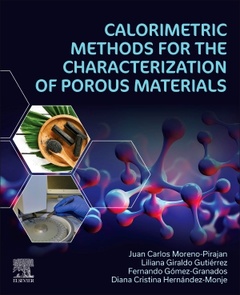Calorimetric Methods for the Characterization of Porous Materials
Auteurs : Moreno-Piraján Juan Carlos, Gutiérrez Liliana Giraldo, Gómez-Granados Fernando, Hernández-Monje Diana Cristina

Calorimetric Methods for the Characterization of Porous Materials presents calorimetric methods used in the characterization of porous materials using chemical thermodynamics. Among these materials, catalysts, supports and adsorbents (such as Activated Carbon, Metal-Organic-Frameworks, SBA-15, Zeolites, Graphene, Graphite, Carbon Foams) are presented. In addition, the use of calorimetry in the study of catalytic reactions in different phases is explored?applicable to air and wastewater treatment, clean and renewable energies, green chemistry, as well as energy production and storage (Carbon dioxide, methane and hydrogenat high pressure). Chapters summarize basic concepts of thermodynamics and kinetics alongside experimental techniques such as thermal analysis and calorimetry. In addition, information is given about different calorimetric methods that can be used in studies aimed at characterizing the physicochemical properties of adsorbents, supports and solid catalysts, as well as the processes related to the adsorption-desorption phenomena of the reactants and/or products of catalytic reactions.
1. Calorimetry: overview of historical development, instrumentation design and construction criteria 2. Calorimetry and thermodynamics conceptualization 3. Instrumentals aspects 4. Calorimetry for the solid-liquid interface 5. Study of gas-phase systems by adsorption calorimetry 6. Applications studies using calorimetry 7. Catalytic and kinetic studies by calorimetry 8. Contributions of calorimetry for the advancement of science 9. Contributions of calorimetry to biology and pharmacy
Liliana Giraldo Gutierrez studied chemistry and obtained her PhD in Chemistry at the Universidad Nacional de Colombia. She has been linked to this university since 1990, obtaining a Magna Cum Laude grade both in her undergraduate thesis as well as in her PhD thesis. She is director of the Calorimetry Laboratory of the Department of Chemistry. Her area of interest is calorimetry, which she uses in the characterization of special materials. She designs and builds her own calorimeters. She has more than 300 publications on thermodynamics to her name.
Fernando Gómez-Granados graduated from the Universidad Nacional de Colombia, a specialist in Geographic Information Systems from the Instituto Geográfico Agustín Codazzi Universidad Distrital, Ph.D. in Analytical Chemistry of the Environment and Contamination from the Universitat de Barcelona, Spain with research in analytical methodology for the determination of antibiotic residues in environmental samples. Currently, he is an Associate Professor in the Department of Chemistry at the Universidad Nacional de Colombia, teaching in analytical chemistry. Has held academic–administrative positions in the Department of Chemistry (academic coordination) and the Curricular Area of Chemistry (director). He h
- Addresses the problems involved with the chemical thermodynamics of porous materials, with a significant practical element explaining experimental parameters and how to perform calculations
- Presents, in detail, the main instrumental calorimetric methods, including those that must be carefully considered to avoid experimental errors
- Demonstrates, step-by-step, how to perform calculations using data obtained from instrumentation to achieve reliable results
- Provides novel explanations on how to use calorimetry in catalyst characterization
- Allows readers to broaden the spectrum of the application of calorimetry in the study of materials
Date de parution : 04-2024
Ouvrage de 264 p.



